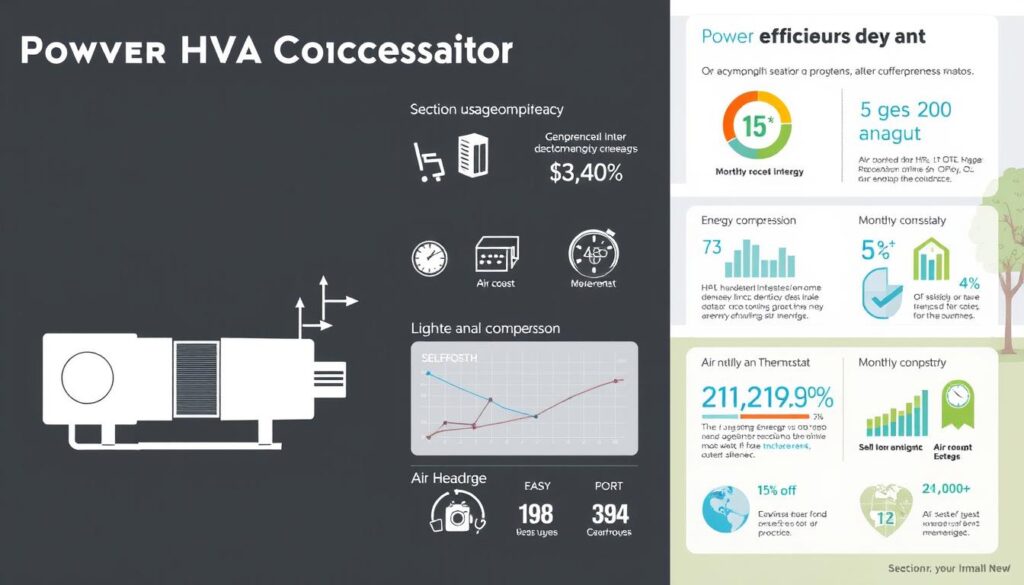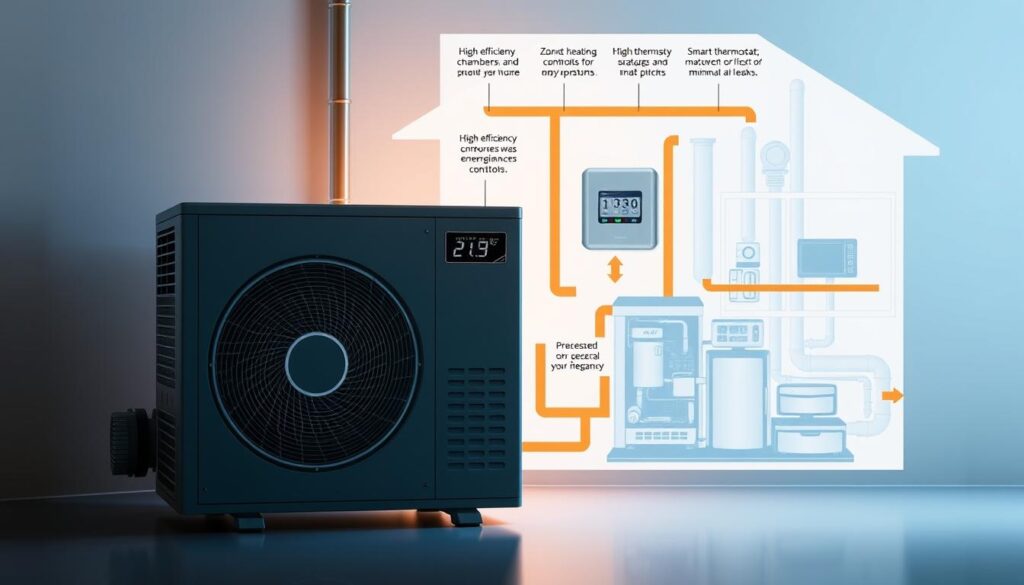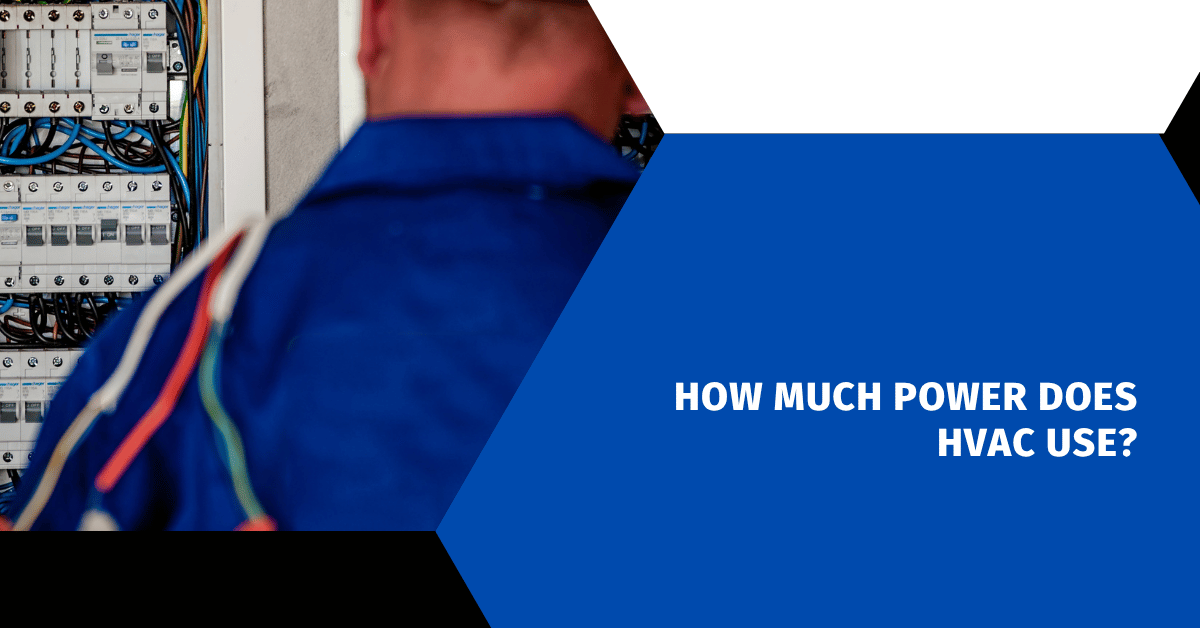Affiliate Disclosure
HVAC Guide Guys is a participant in the Amazon Services LLC Associates Program, an affiliate advertising program designed to provide a means for sites to earn advertising fees by advertising and linking to Amazon.
How Much Power Does HVAC Use? Ever thought about how much electricity your home’s heating and cooling system uses? It’s not just about numbers. It’s about helping homeowners save money and make better choices.

The Energy Information Administration says about 9% of a typical home’s energy goes to cooling. This might seem like a small amount. But, it can really add up to your electricity bill.
Your HVAC system does more than just control the temperature. It’s a big energy user that affects your home’s energy efficiency. Learning about HVAC power use can help you save money.
Key Takeaways
- HVAC systems represent a significant portion of household energy consumption
- Understanding power usage can lead to substantial cost savings
- Energy efficiency varies across different HVAC system types
- Climate zones significantly impact HVAC power requirements
- Strategic energy management can reduce overall electricity costs
Table of Contents
Understanding HVAC Power Consumption Basics
Knowing how much electricity your heating and cooling use is key to saving money. HVAC systems use a lot of energy in homes. So, it’s important to understand how much power they need.
There are many types of heating and cooling systems, each needing different amounts of energy. Let’s look at the main points about HVAC power use. This will help you make better choices for your home’s energy.
Exploring HVAC System Types
Different HVAC systems need different amounts of power. Here’s a quick look at some common types:
- Central Air Conditioning: Uses 3000-3500 watts per hour
- Window Units: Need 900-1440 watts per hour
- Heat Pumps: Depend on climate and efficiency
- Ductless Mini-Split Systems: Often more energy-efficient
Critical Factors Influencing Energy Usage
Several things affect how much electricity your HVAC system uses:
- How well your home is insulated
- The local weather
- The age and upkeep of your system
- The size of your home
Decoding Energy Measurement Units
To get a handle on power use, you need to know a few key units:
- Watts: Measures electrical power
- Kilowatts (kW): 1000 watts
- British Thermal Units (BTUs): Measures heat energy
Pro tip: Knowing these units can help you choose more energy-efficient options for your home’s heating and cooling.
Explore Our HVAC Shop
Looking for top-rated HVAC tools, parts, and accessories? Visit our shop and find the perfect solution for your needs.
Visit the ShopAverage HVAC Energy Consumption by System Type
Knowing how much energy your HVAC system uses is key to keeping your home comfy and saving on bills. Each system has its own power rating and energy efficiency level. These factors affect how much electricity you use.
In the U.S., the average home uses about 2,365 kWh of electricity each year for cooling. This number changes based on the type of HVAC system you have.
- Central Air Conditioning: Uses 3,000-5,000 kWh yearly
- Heat Pumps: Use 2,000-4,500 kWh annually
- Ductless Mini-Split Systems: Use 1,500-3,000 kWh yearly
- Window Units: Use 500-1,500 kWh, depending on size and use
The power rating of your HVAC system is key to its energy use. New, efficient systems use less electricity than older ones.
| HVAC System Type | Average Annual Energy Consumption | Typical SEER Rating |
|---|---|---|
| Central Air Conditioning | 4,000 kWh | 13-16 SEER |
| Heat Pump | 3,500 kWh | 14-18 SEER |
| Ductless Mini-Split | 2,250 kWh | 16-22 SEER |
| Window Unit | 1,000 kWh | 10-12 SEER |
“Investing in a high-efficiency HVAC system can reduce your energy consumption by up to 30%.” – Energy Star
Things like your home’s size, the climate, and how well you maintain your system affect energy efficiency. Keeping your system in good shape and using it wisely can cut down on electricity costs.
How Much Power Does HVAC Use in Different Climate Zones
Your HVAC system’s power use changes a lot based on your location. The climate zone you’re in greatly affects how much energy your system uses. This is true across the United States.
Knowing how your local climate affects your HVAC’s energy use is key. It helps you make better choices for your home’s heating and cooling.
Hot Climate Power Usage Patterns
In hot places like Florida and Arizona, HVAC systems work hard. They use a lot more power to cool down. People in these areas often see:
- Higher cooling demands in long summers
- More energy use for cooling all the time
- Up to 5,000 kWh of cooling energy use each year
Moderate Climate Energy Consumption
Places with mild weather, like California and parts of the Southeast, use energy more evenly. These areas usually have:
- Lower peak energy needs
- More consistent heating and cooling needs
- Moderate power use for temperature control
Cold Climate HVAC Requirements
In northern states like Minnesota and North Dakota, HVAC systems face special challenges. They use a lot of power to heat during long winters. Key points include:
- Higher heating energy use
- Need for more efficient systems
- Heating energy use around 1,200-2,000 kWh each year
| Climate Zone | Typical Annual Cooling kWh | Typical Annual Heating kWh |
|---|---|---|
| Hot (Zone 1A) | 4,949 | 500 |
| Moderate (Zone 3A) | 2,500 | 1,000 |
| Cold (Zone 6A) | 1,209 | 2,200 |
Data sourced from U.S. Department of Energy ResStock database
Explore Our HVAC Shop
Looking for top-rated HVAC tools, parts, and accessories? Visit our shop and find the perfect solution for your needs.
Visit the ShopImpact of Home Size and Layout on HVAC Power Usage
Your home’s size and layout are key to hvac energy efficiency. Bigger homes need more power for heating and cooling. Knowing this can help cut down hvac power costs.
Different home designs affect HVAC performance. Open floor plans, high ceilings, and multiple floors pose unique thermal challenges. Smart design can boost your system’s efficiency.
- Square footage directly correlates with energy consumption
- Ceiling height impacts thermal regulation
- Floor plan complexity affects air circulation
- Window placement influences heat gain and loss
To boost hvac energy efficiency, try these layout tips:
- Create distinct temperature zones
- Improve insulation in key areas
- Seal air leaks around windows and doors
- Install reflective roof materials
| Home Size | Average HVAC Power Usage | Efficiency Level |
|---|---|---|
| 1,000 sq ft | 3-5 kWh | High |
| 2,500 sq ft | 8-12 kWh | Medium |
| 4,000+ sq ft | 15-20 kWh | Low |
Professional tip: Smaller, well-designed homes can reduce HVAC power consumption by up to 40% compared to larger, inefficient structures.
SEER Ratings and Their Effect on Energy Consumption
SEER ratings are key to understanding HVAC energy efficiency. They help you use less power and cut down on energy costs. SEER (Seasonal Energy Efficiency Ratio) shows how well an air conditioner cools compared to its power use over a season.
Today’s HVAC systems are getting better at saving energy. The newest standards have introduced SEER2 ratings. These ratings give a more precise look at how well a system performs.
Understanding SEER and SEER2 Ratings
SEER ratings let you compare different HVAC systems. Here’s what you need to know:
- Lower SEER ratings mean less efficient systems
- Higher SEER ratings lead to more energy savings
- New models usually have SEER2 ratings between 13 and 21
How Efficiency Ratings Translate to Power Usage
A higher SEER rating means you use less energy. For example, going from a 10 SEER to a 16 SEER system can cut electricity use by up to 60%. This can save you a lot on your monthly bills.
Calculating Energy Savings with Higher SEER Ratings
When looking for a new HVAC system, think about the savings. High-performance heat pumps with 16-20 SEER2 ratings can get you federal tax credits. This makes them a great choice for those who care about energy.
By focusing on SEER ratings, you can choose a better HVAC system. This leads to big improvements in energy efficiency.
Explore Our HVAC Shop
Looking for top-rated HVAC tools, parts, and accessories? Visit our shop and find the perfect solution for your needs.
Visit the ShopCalculating Your HVAC’s Power Consumption

Understanding your HVAC electricity bills starts with knowing how to calculate power requirements for HVAC systems. Tracking your energy consumption helps you manage costs and improve efficiency.
To estimate your HVAC’s energy use, you’ll need to follow a few key steps:
- Identify your system’s British Thermal Unit (BTU) rating
- Check the Seasonal Energy Efficiency Ratio (SEER) rating
- Calculate daily and monthly energy consumption
The basic calculation for cooling wattage involves dividing the BTU rating by the SEER rating. For example, a 24,000 BTU system with a SEER rating of 16 would consume approximately 1,500 watts.
| HVAC System Size | Average Daily Watts | Estimated Monthly Cost |
|---|---|---|
| 1-2 Ton System | 1,000-1,500 watts | $50-$75 |
| 3-4 Ton System | 1,500-2,500 watts | $75-$125 |
| 5+ Ton System | 2,500-3,500 watts | $125-$200 |
You can simplify this process by using online energy calculators specific to your HVAC model. These tools help break down power requirements for HVAC systems with precision.
Pro tip: Keep your energy bills and system specifications handy when performing these calculations. Regular monitoring can help you identify and fix inefficiencies, reducing your HVAC electricity bills.
Peak vs. Off-Peak HVAC Power Usage
Knowing how power use changes can help save money and energy at home. Electricity prices change throughout the day. This gives you chances to use less HVAC power and cut costs.
Electricity rates vary between peak and off-peak hours. Peak hours are when most people use electricity, usually from 4-9 PM on weekdays. Rates are highest during these times.
Managing Power Consumption During Peak Hours
Here are ways to lower HVAC energy costs during peak times:
- Pre-cool your home during off-peak hours
- Use programmable or smart thermostats
- Adjust temperature settings slightly higher
- Implement zone cooling techniques
Optimizing Off-Peak Operation
Off-peak hours are late at night and early morning when demand is low. Moving your HVAC use to these times can save a lot of energy.
| Time Period | Electricity Rate | Recommended Action |
|---|---|---|
| Peak Hours (4-9 PM) | Highest Rate | Minimize HVAC usage |
| Off-Peak Hours (11 PM-5 AM) | Lowest Rate | Optimize HVAC operation |
Think about using thermal mass cooling. Cool your home during off-peak hours. This stores cool energy and lowers system work during expensive peak times.
Energy-Efficient HVAC Operation Strategies

To cut down your HVAC energy use, you need smart strategies. These can greatly lower your power bills. Every little change in your thermostat can save up to 3% on energy.
Smart homeowners can take several steps to make their HVAC systems work better:
- Set programmable thermostats to adjust temperatures automatically
- Utilize ceiling fans to enhance air circulation
- Perform regular maintenance on HVAC equipment
- Improve home insulation and seal air leaks
Managing your home’s temperature is key to saving energy. Here are some tips:
- Raise thermostat settings during summer by 7-10 degrees when away
- Lower settings during winter when sleeping or out of home
- Use zoning strategies to target specific living areas
“Small changes in HVAC operation can lead to substantial energy savings over time.” – Energy Conservation Expert
By using these strategies, you can lower your energy use, cut down on electricity costs, and help the environment.
Explore Our HVAC Shop
Looking for top-rated HVAC tools, parts, and accessories? Visit our shop and find the perfect solution for your needs.
Visit the ShopModern HVAC Technologies and Power Savings
The HVAC world is changing fast, with new ways to save energy and keep homes comfy. Homeowners can now use the latest tech to cut down on energy use without losing comfort.
New technologies are changing how we think about saving energy with HVAC. These systems are smarter and more responsive than old methods, making homes more efficient.
Smart Thermostats: Intelligence Meets Efficiency
Smart thermostats are a big step forward in controlling your home’s climate. They learn your likes and when you’re home, then adjust to save energy.
- Machine learning algorithms predict your comfort needs
- Automatic adjustments based on occupancy and weather
- Remote control through smartphone apps
- Potential energy savings up to 15-20%
Variable Speed Systems: Precision Power Management
Variable speed HVAC systems are another big leap in saving energy. They can adjust their power to exactly what your home needs, unlike old systems.
- Continuous operation at lower speeds
- Reduced energy consumption
- More consistent indoor temperatures
- Lower noise levels during operation
By choosing these modern technologies, you can greatly cut your home’s energy use. And you’ll stay comfortable too.
Conclusion
Understanding and managing your HVAC power use is key to saving money and making your home greener. By using the tips from this article, you can cut down on energy use. This keeps your home comfortable without breaking the bank.
Today’s HVAC tech offers big chances to save energy. Smart thermostats, variable speed systems, and high-efficiency ratings help you use less power. Keeping your system in top shape and using it wisely can really lower your bills.
The future of heating and cooling is all about being efficient and eco-friendly. As tech gets better, you’ll find more ways to make your home energy-smart. By choosing wisely for your HVAC, you help save money and protect the planet.
Every little bit counts when it comes to saving on HVAC costs. Upgrading, changing how you use it, or getting energy-saving tech all help. Your efforts make a big difference in saving energy and making your home more eco-friendly.

